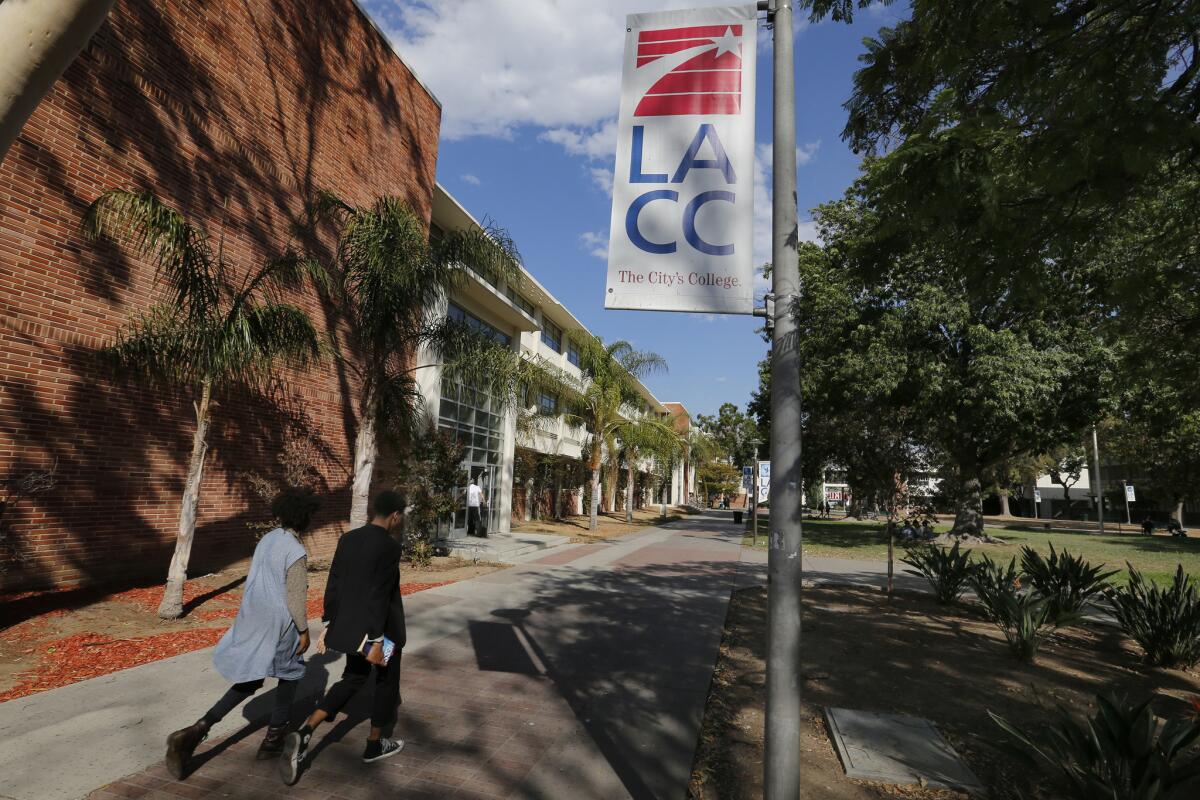L.A. targets full-time community college students for free tuition

At 19, Maria Medrano of Echo Park is already halfway to earning her associate’s degree at Los Angeles City College.
Her sister, who is three years older, works during the day to support their family and takes classes at night. So even though she started community college earlier than her little sister, she’ll end up graduating later.
“If I had to work, I wouldn’t be as focused as I am right now,” Medrano said as she sat hunched over an unfinished essay in LACC’s student union. “I’d be struggling, as I’m seeing my sister struggle.”
At Los Angeles’ nine community colleges, Medrano’s sister’s experience is the norm. Many students are burdened by rent payments, textbook costs, and average tuition fees of $1,300 a year, and 73% go to school part time. Research shows that they are less likely than their full-time peers to complete a degree or transfer to a four-year college.
That’s one reason for a new plan promoted by Mayor Eric Garcetti to offer graduating high school students one year of free community college.
L.A. College Promise, first proposed during Garcetti’s State of the City address last spring, applies only to graduates of L.A. Unified high schools. And only full-time students who maintain a 2.0 grade point average can receive the aid.
The hope is to persuade students to quit their day jobs and focus on college.
We’re going to solicit from every company in Los Angeles that has their name on a building downtown.
— Scott Svonkin, president of the board of the Los Angeles Community College District
“A lot of our students work and go to school and so we’re hoping that some of them will decide to go full time because of the extra help,” said Scott Svonkin, president of the board of the Los Angeles Community College District. “We’re taking one barrier, one burden, away. And we know if they go full time, students succeed in astronomically higher numbers.”
A financial aid program run by the California Community Colleges Board of Governors already allows most graduates of L.A. public schools to attend local community colleges for free. About 69% of these students have all of their tuition fees waived, according to a district official. Other qualifying students receive assistance for tuition and textbooks from the Cal Grant program, the largest source of state-funded college aid.
The mayor’s plan — which is expected to cost $3 million the first year — targets an estimated 2,100 students who will graduate from L.A. high schools in 2017 and whose families’ earnings probably will be too high to qualify them for a Board of Governors tuition waiver. Though families in this situation may make too much money to be eligible, they often still make too little to support their children through college.
L.A. College Promise resembles President Obama’s proposal in his 2015 State of the Union address to offer two free years of community college to all U.S. students. It also includes proposals to help students fill out financial aid applications, which can be dauntingly complex, and to give them priority when registering for classes to ensure they aren’t locked out of the courses they need to graduate. Extending the tuition benefits to two years is the ultimate goal, Svonkin said.
“When I look at the underlying thinking, I’m fairly encouraged,” said Thomas Bailey, a professor of economics and education at Teachers College at Columbia University and director of its Community College Research Center. “The kind of reforms that surround L.A.’s plan, reforms that deal with the problems students face, those are as important or probably more important than the tuition assistance itself.”
The Promise proposal could lead to an increase in enrollment at community colleges, Bailey said. In states that have offered similar assistance, students who previously did not think they could afford college applied. Some discovered only then that they would have qualified for financial aid anyway.
To pay for the program, the Mayor’s Fund for Los Angeles has raised $1.8 million, said Garcetti spokeswoman Connie Llanos, including an $800,000 donation from the Karsh Family Foundation, $400,000 from the Broad Foundation and a $200,000 contribution from the L.A. Dodgers. The rest of the money is expected to come from the community college district, which so far has raised $30,000.
“We’re going to solicit from every company in Los Angeles that has their name on a building downtown,” Svonkin said. “If they can afford to put their name on a building, they can afford to donate to this.”
Convincing students to attend community college full time, however, may take more than offering one free year.
Even with a tuition waiver, Medrano said she relies on her parents to help her pay for textbooks, which can cost her as much as $500 a semester.
Full-time student Katherine Castillo, 18, can rattle off a list of her expenses that aren’t entirely covered by her Cal Grant, which pays for most of her tuition. There’s the $200 a month toward an apartment in Koreatown that she shares with her mother, not to mention the textbooks, school supplies, and daily transportation to and from the City College campus.
Castillo has a discounted Metro TAP card offered to college and vocational students, and several campus programs distribute vouchers for books — but so far no one has volunteered to buy her groceries or write a check to her landlord.
“I need to help my mom out and I need to pay for my own personal needs like clothing, food, etc.,” she said. “So the initiative is going to be useful, but it’s not going to be useful for the students who actually do need the extra cash.”
Castillo said she is pretty sure she will have to look for a job next semester. Once she’s working, she plans to go to school part time.
Twitter: @annamphillips
To read the article in Spanish, click here
More to Read
Sign up for Essential California
The most important California stories and recommendations in your inbox every morning.
You may occasionally receive promotional content from the Los Angeles Times.











